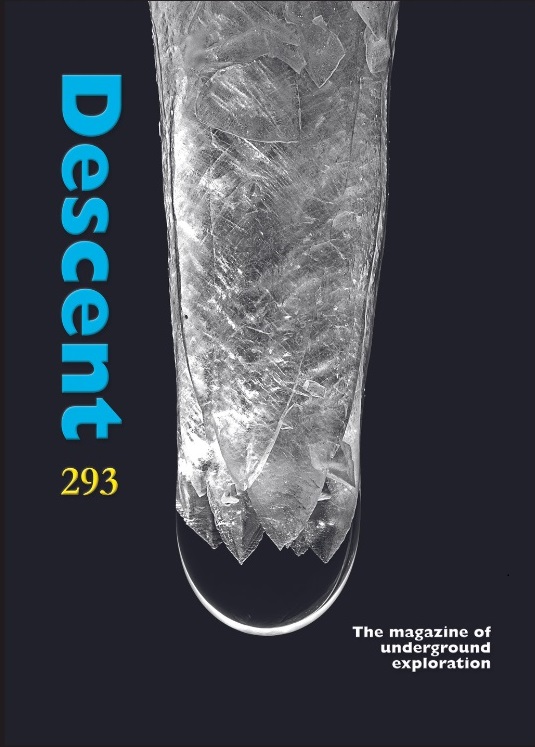
Descent 293 is now published and without further ado, here is a review!
There is one article in this issue that, for me, stands out from the others. But more of this later.
The regular news pages contain a fascinating description of the exploration of a section of Easegill’s Pegleg Pot, which is normally flooded but became accessible to dry cavers during the drought in June. Cave maintenance and conservation work is reported at Wretched Rabbit, Swinsto, and Malham Cove Rising. There are several Forest of Dean news items, including implanting a false tooth into Norman the Dog, an impressive bat-counting exercise, and the screening of Paul Taylor’s Otter Hole film.
From the Peak area we learn of some curious passages at Crich which have been explored recently, and from Ireland the relocation and tracing of the Coolagh River Cave rising is described. Chris Jones describes the frustration of looking for old mines in northern Spain, an area more often visited for the magnificent caves of the region. Chris suggests that visiting these high regions might yield more results later in the year when the snow plugs on the mountains would be less of an issue.
Martyn Farr, Welsh Correspondent, keeps us up to date on the state of Llygad Llwchwr 2 entrance, problems with Tunnel Cave access, and an extension to the Croesor-Rhosydd slate mine through trip. International news covers developments on the 2023 Cheve expedition in Oaxaca, Mexico, and the Sistema Huautla 2023 expedition in April.
The first of the features is an eye-opening description of a photographic project to record the intricate details of straws in Hunter’s Lodge Inn Sink, in Somerset. Dave Watts explains the challenges of recording the minute details of crystal growth at the tips of straw stalactites. The painstaking work required to create the images with such sharp detail is explained and the results are an excellent testament to the patience and effort required to create them. This is the article that for me stands out so much in this issue.
Portland, in Dorset, contains some surprisingly extensive caves. Tim Rose describes how a short cave, Hopeless Hole, has been extended in recent years. By connecting it up to other nearby caves, Tim estimates that the system now has approximately 3km of passage, and 8 entrances.
There have been regular annual expeditions to the Dachstein mountain in Austria, only interrupted recently by the covid-19 pandemic. Interest in this area has now been renewed, and Becca Lawson provides an account of recent visits to the area, including the CUCC 2022 expedition to the extensive karst of the Totes Gebirge. Becca describes the prospecting work, and the sometimes frustrating exploration into numerous choked shafts and tight rifts. However, the impressive discoveries that are made, several of which are described, draw UK cavers back each year in encouraging numbers.
I like a good mine exploration report, so I was pleased to read Jon Pemberton’s article on recent visits to Hartle Dale Bottom Mine in the Peak District. Accompanied by some excellent photos, the article describes the exploration of the shaft and connected workings over six weeks, finding evidence of previous visits some 40 years earlier, and some well-preserved signs of the lead-miners themselves.
Bob Mehew would appear regularly at Hidden Earth with a rope testing device, and offer to destroy any rope presented to him! In this issue, Bob writes about the dynamic drop capacity of caving rope.
The final article is a tribute to caver and film-maker Guy Meauxsoone, written by his friend and fellow film-maker, Sid Perou.
The Descent Magazine team would love you to sign up for a subscription, so if you haven’t already done so, then visit the Descent website to set one up.
https://www.descentmagazine.co.uk/shop/descent-subscription/
Correspondent: Peter Burgess
